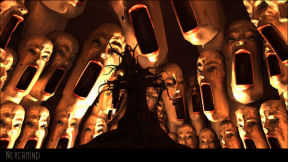flotsam's "First Look" at Nevermind...

Nevermind
Flying Mollusk
It’s hard to resist a game that says it gets harder the more scared you get. Except I need a biofeedback sensor that is still in the mail, so this first look was played the old fashioned way and at this stage isn’t yet scary or panicky.
But it is intriguing.
You play as a Neuroprober – “a unique physician who, through the use of cutting-edge technology, is able to venture into the minds of psychological trauma victims for whom traditional treatment methods have proven ineffective”. By entering directly into the mind of the patient, you can recover fragments of memories (represented by photographs) surrounding the traumatic event, and attempt to treat said patient.
Needless to say, the subconscious can strike back.
The first part of the game is a training day, to essentially settle you into how to play. You enter a mind of surrealistic images, and explore to find photos representing real or imagined memories. You learn about the trauma involved, and ultimately have to sort through the images, deciding what is real and what isn’t. Then it’s on to a real patient, and their “demons”.
So far I haven’t gone far, as I am keen to play with the sensor. According to the website, the game was “developed to help players become more mindful of their feelings of stress and anxiety levels and help them practice managing those feelings of fear and stress”. As I understand it, and simplistically put, if you panic or are stressed, the game amps up the difficulty, accentuating the stress and further increasing the intensity. The key is managing the stress, which makes sense – if your car drives off the bridge into a river and is filling up with water, I imagine the best way to get out is to remain as calm as possible and think as clearly and as carefully as possible (and have one of those little window breaking tools the Mythbusters had). Screaming and yelling will probably get you drowned.
There are dark themes and dark environments involved – literally and figuratively. I did what the set up screen said and adjusted the gamma until I could just see the image, and then spent a good bit of the training day fumbling and stumbling around in the dark. Turning it up a bit made all the difference – I could actually see where I was going and what I was doing. While I don’t want to banish the “darkness” altogether, as I imagine it will be a part of the goings on, I will continue to fiddle with the level to get a good balance. I recommend you do the same.
Nevermind is currently in early access (a “beta, in-development work-in-progress version”), and a full version is planned for Fall (or Spring for us downunder types). Between now and then the sensor will arrive, and I will let you know how I fared.
I played on:
OS: Windows 7
Processor: Intel i7-3820 4GHz
RAM: 12GB Ripjaw DDR3 2133 Mhz
Video card: AMD Radeon HD 7800 2048MB